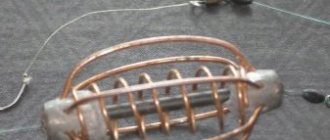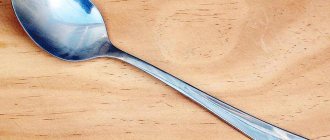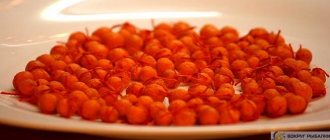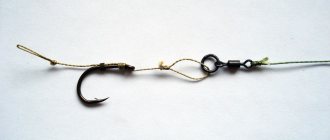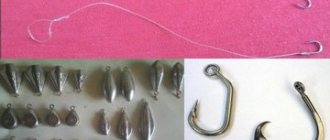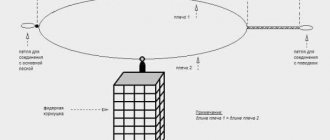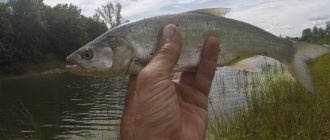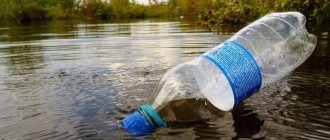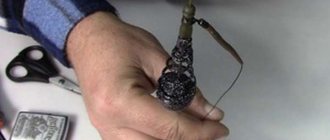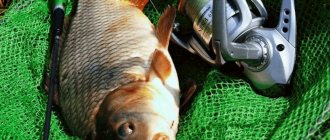Donka for carp is an old, proven method of fishing for the giant of our reservoirs. In the last 5–7 years, sport fishing for carp, or carp fishing, has been actively popularized, and serious financial investments are required to practice this sport. But budget fishing deserves no less attention, so catching carp on a donkey on a river or lake has become a favorite pastime for most anglers.
Why we are talking specifically about carp is understandable, because it is one of the most common inhabitants of our reservoirs. In addition, unlike crucian carp, adult carp reach large sizes, and catching a qualifying trophy is the dream of every angler.
Carps are found both in rivers and in closed reservoirs and perfectly adapt to natural conditions. The main thing is that there is a food supply, thanks to which young individuals grow quickly, gain weight and, as a result, are of great interest to fishing enthusiasts.
In this article we will talk about how bottom tackle for carp is tied, in what conditions it is best to use it and how to properly catch this strong fish.
Where to look and how to catch carp on a donk
The correct choice of place for fishing is 50% of success when fishing for carp, because it is not roach or crucian carp, which are found in large quantities in every body of water. Much depends on the time of year and the conditions in which fishing takes place, but carp have favorite places in each body of water, as well as paths along which they go in search of food.
Finding such places requires attention and there are several standard recommendations in this regard. During the daytime in hot weather, trophy fish prefer to hide in holes and need to be caught at the exits of holes, on edges or in places overgrown with grass. Reed beds are also a haven for carp, so positioning your rig near dense brush will increase your chances of getting a bite.
In turbulent rivers, fish are looked for in calm places, at turns and near undercuts, where the flow slows down and there is plenty of food. During the cold periods of the year, spring and autumn, small places that are well warmed up by the spring sun are of particular interest, because carp is a heat-loving fish and becomes active only after the water temperature reaches 10–12 degrees.
Carp can also be caught in winter from ice or in clear water, but this is a special type of fishing that deserves separate consideration. We are talking about those periods when the fish are active, and it is more comfortable for the fisherman to be on the shore of the reservoir and do what he loves. With closed reservoirs, stakes and small lakes, everything is simpler; in such conditions, a visual inspection helps to determine where the fish come out, and it is more convenient to cast or bring in equipment.
Carp are schooling fish and individuals weighing up to 5–7 kg gather in groups of 10–15 individuals. This means that if you managed to attract fish to the fishing point, and a bite occurred, with a high degree of probability you should wait for the next bites. Trophy carp prefer to stay alone and only gather in small groups during spawning.
Fishing for carp in a small pond
Basically, fishermen who want to return home with a decent catch prefer to use the services of fisheries, of which there have recently been many in many regions of the country.
Almost all stories about how to catch carp in a pond, if the pond is paid, come down to one thing. Having arrived at the place and having paid a certain amount of money, all that remains is to throw in the bait and bait and wait for the first bites. There is no need to complain about the size of the prey.
The reason for such a fast bite is that the owners of paid ponds are constantly stocking their lands with fish. It is for this type of fishing that does not require much effort that people are willing to pay a certain amount.
Moreover, in many farms they charge a fee not only for entering the territory and the opportunity to fish, but also for the catch (per kilogram) and for permission to take it with you.
It is recommended to choose a braided line, as strong as possible, and a hook such that it can easily hook large fish. You don't have to worry too much about bait.
There, the fish will bite on everything, so to some extent, part of the money that you will pay for comfortable fishing can be justified by using less bait. When landing prey, even if it is not as large as you would like, always use a landing net.
Firstly, this will give one hundred percent confidence that at the most inopportune moment the fish will not fall off the hook, and secondly, the use of such a device will injure the fish less than dragging it along the coastal strip.
How and what to feed
Another important factor influencing the effectiveness of carp fishing for donka is the quantity and quality of bait that is offered to the fish. Only in early spring and late autumn the amount of food should be minimal, because the carp is not active and its metabolism is slow.
It is very easy to overfeed in such conditions and this must be taken into account when determining the volume of the feeding mixture. When fishing in warm water, it is necessary to feed the fish and it is necessary to choose the correct ratio of ingredients. It’s worth saying right away that catching carp without feeding the fishing point is much more difficult and it will most likely be a fish passing by by chance.
Even in small bodies of water, feeding is necessary, especially since the bait mixture contains accessible and cheap components.
For feeding it is used:
- boiled and fermented corn;
- boiled peas;
- wheat;
- rape;
- millet;
- sunflower cake.
All grains are available and have a low cost, so their use is justified in amateur bottom fishing. There are reservoirs where bait made from sour peas or corn performs well; they are also used as bait.
In order not to make a mistake in choosing the components of the bait mixture, you need to ask what the owners of the reservoir feed the fish (if it is a “private owner”), because it is accustomed to this food. Most often, grains from nearby fields are used as food, because both carp and grass carp happily feed on such food. So the guards of the reservoir will certainly suggest the right decision.
If fishing is carried out on the river, the universal bait is boiled and dry corn, which works for carp and carp at almost any time of the year. When the equipment is delivered, 3–5 grains of dried or boiled corn are poured into the fishing point, and after each bite the same amount of bait is added. If, when fishing on the river, there is no bite for 2-2.5 hours, you need to supplement the point and change the bait to a fresh one.
Don’t be afraid to overfeed fish in warm water, because young carp can eat more than their own weight in food per day. And corn and peas are the ingredients that will help attract fish to a given point, and to catch them, bottom equipment, or simply a donka, is used.
Lure
Carp is a schooling fish; small and medium-sized individuals often stay in groups of 10-15 fish. Therefore, if you manage to attract him with bait, wait for the whole flock to approach.
Both store-bought and homemade mixtures are used. The main components of homemade bait are as follows:
- Breadcrumbs
- Cake
- Small boilies
- Corn
- Wheat
- Feed bloodworm
Honey, vanilla, and garlic are used as flavorings.
If we talk about store-bought baits, the following are popular:
- Dunaev Premium Carp Carp
- Minenko PMbaits Carp
- Traper Big Carp
You will need a lot of bait, especially in summer. In warm weather, carp can be very voracious.
In early spring and late autumn in cold weather, the amount of complementary feeding should be kept to a minimum, or you can easily overfeed the fish.
How to collect donka for carp
In this article, we are not considering sports carp or feeder gear; we are talking only about amateur fishing and all available equipment, the purchase of which does not require significant costs.
You don’t need to think that to catch trophy fish you need imported equipment, rods, reels and fishing lines, because carp have been successfully caught in our reservoirs since time immemorial, and there are no obstacles to continuing to do so.
Rod
The length of the rod is selected depending on whether the equipment will be brought in on a boat, or cast from the shore “by hand”. For imported fishing, budget telescopic or plug rods with a length of 2.7-3.00 are used, which are convenient to handle in cramped conditions while sitting on a boat.
For long-distance casting from the shore, you need a rod with a length of 3.3 - 3.9 with a cast of at least 100 grams. It doesn’t have to be a carbon “stick”; a “crocodile”, well known for its reliability and durability, capable of withstanding heavy loads, will also do.
We will not offer specific names of fishing rods, because the assortment in stores is different, the main thing you need to understand is that they catch no less fish with a budget form than with an expensive one, so it’s better to save money.
Coil
A spinning reel with a 4000-5000 spool is an ideal option, but in its absence, even a 3 thousand reel will provide convenience when casting and retrieving fish, even if it is somewhat more difficult to do. The technical characteristics of budget reels are not much worse than products from well-known brands, so don’t chase names, functionality is much more important.
Considering that amateur carp fishing involves a large number of rods, reducing the cost of gear is only welcome. But it’s better not to skimp on fishing line, especially if fishing is carried out in the current, in snags and hard-to-reach places. After hooking, the carp will probably show fierce resistance and in order to prevent it from going into the reeds or getting caught on snags, a strong and low-stretch line is needed.
fishing line
For fishing from the shore and casting, a monofilament line with a diameter of 0.3-0.35 mm is best suited. If you choose a thinner line, there is no complete confidence in the reliability of the gear, especially when you encounter a large fish. A main line with a diameter greater than 0.35 limits the casting range, and when fishing long-distance it is very difficult to accurately place the equipment at the point.
When fishing from a boat, especially in snags, it is best to choose a braided line with a diameter of 0.2-0.25 mm as a base. The low stretch of the braided cord makes it possible to make a clear hook, and when fishing, it is easier for the fisherman to hold the fish and not let it go into the reeds or snags.
The cost of braided cord is higher than monofilament fishing line, but with proper use it lasts for several seasons, the main thing is to dry the base after fishing and store it in a dark, cool place. Before fishing, be sure to check the condition of the fishing line, because it will be very disappointing if, when fishing for a trophy, the tackle breaks due to a poor-quality base.
Monofilament fishing line is also stored in a dark and dust-free place; in extreme cases, the reels are placed in plastic bags. Most often, more fishing line is wound onto the reel spool than is needed for fishing, and after several fishing trips it is rewound to another spool so that the working part remains fresh.
Leads hooks and sinkers
When fishing for carp, you need to be prepared for a trophy fish to bite, so the hooks you choose are strong and sharp. Every time before casting or bringing in the rod, check the sharpness of the hook, because your catch ultimately depends on it. Hook size 2-6 according to the classical classification, preferably Wide Gape shape, with a wide hook.
As for specific manufacturers, the choice depends on the fisherman’s budget; the best option is Hayabusa KX-1 hooks. This is a budget, but high-quality hook that can hold trophy fish.
Now there are many good Chinese hooks, but you need to choose them only after visually verifying their high quality and sharpness. To knit leashes, use soft leash material or a strong cord that ensures the reliability of the tackle.
Important! Remember that inattention when choosing a hook and tying the rig will result in an unfortunate loss of fish.
Cargo requirements:
- dark, better camouflage color;
- weight sufficient to hold the current and hook the fish on its own;
- streamlined shape (bullet, cylinder).
Homemade cast weights do their job well, and you can paint them a camouflage color using dry paint. Using such cargo is another opportunity to save money.
A few words about the correct equipment of a donkey with a feeder
When using bottom carp gear, you need to pay special attention to the correct installation of the structure. Experienced fishermen know that carp are very strong and resourceful, and therefore, if you lose sight of even one nuance, you should not count on a good catch.
- Equip the tackle with a sliding weight (in many cases it will be replaced by a feeder). This should be done so that when the fish bites, they do not feel resistance. Otherwise, she will simply swim away from the treat. To install a sliding sinker, you need to make two knots on the main line so that a segment 10-20 cm long is formed between them. The knots will serve as limiters for the stroke of the weight.
- Sometimes, while using gear, fishermen replace leashes, since it is not always possible to predict the behavior of the fish. If there is no bite for a long time, try replacing the leash with a thinner and not so long one. The hook should be of a smaller number. But in order to quickly tie the equipment on a pond, it should be prepared at home in advance.
- When catching large carp (more than four kilograms), use self-hooking gear such as asymmetrical loops, inline. If you are quite satisfied with smaller specimens, then the most ideal option is a paternoster. This option has increased sensitivity to bites, which significantly increases the likelihood of a catch.
Nozzles
The best baits for catching carp on donkeys are old dry corn and sour peas, this has been tested by many fishing trips on different bodies of water. There is no need to invent anything if there are baits whose catchability is beyond doubt. Large corn is drilled across and placed directly on the hook tip.
The second option is to attach corn or peas to the hair, which is also effective and works both on the river and on the lake. Even after standing in water for many hours, dried corn remains dense and remains attractive to fish. This is natural food that will not alert even large fish and will entice it to bite.
If you want to experiment, you can try boilies or pellets, but then you need to feed them with a mixture that contains the same ingredients. On some reservoirs, especially closed ones, boiled potatoes, diced, and even pieces of fried lard performed well.
Montages
The choice of rig for catching carp on a donk depends on:
- fishing conditions;
- the presence of a current in a reservoir;
- distances;
- way of feeding.
If fishing is carried out in a well-fed place, additional means of delivering bait such as feeders are not needed. If you have to cast while fishing, a rig is tied using a spring feeder or a plastic feeder, so that after each cast an additional portion of bait gets to the fishing point.
Installation for fishing on the current
To connect a rig for fishing in the current you will need:
- leash with hook;
- sinker with a through hole;
- swivel;
- stop bead or rubber stopper.
The equipment is knitted on a separate piece of fishing line 40-50 cm long and mounted on the base using the loop-to-loop method.
Installation procedure:
- tie the swivel to the fishing line;
- put on the rubber stopper and lower it to the swivel;
- put a sinker on the line;
- put on another stopper;
- at the free end of the fishing line, make a loop for attaching to the base;
- tie the leash to the swivel.
The result is a sliding installation, and the sinker moves freely along the fishing line, limited on both sides by stoppers. After the fish takes the bait, it does not feel resistance for several seconds, because the line glides freely. Only after the load rests against the upper stopper, the soft tissue is caught and all that remains is to bring the fish ashore using a boat, or manually.
The length of the leash is 20–30 cm and soft leash material or cord is used for tying it. This is important, since a leash made of monofilament line or fluorocarbon is too hard and may not be liked by the fish, and hooking on soft leashes is more reliable.
It is not necessary to take expensive leash materials for tying leashes; a budget cord will also do, the main thing is that its breaking load is sufficient for calmly playing the trophy.
When fishing from a long distance, you should not tie several leashes. The fish will still find a hook with a nozzle in a pile of food, and an extra leash becomes a hindrance when fishing, especially from a distance.
The weight of the load must be such that the equipment is not carried away by the current, and reliable self-notching occurs. But a sinker that is too heavy should also not be used, because it will only complicate the task of landing fish due to the additional weight.
Installation with a spring feeder for fishing on a standing pond from the shore
Casting rigs are tied on a fishing line or cord, the thickness and strength of which is higher than that of the base.
This is necessary so that in the event of a snag, only the installation itself comes off, and the base remains intact. Usually a break occurs at the junction of the rig with the base, and to continue fishing all that remains is to tie on a new rig.
To make the installation you will need:
- a piece of thick fishing line from a cord 40–50 cm long;
- spring feeder;
- two swivels;
- two leashes with hooks.
Knitting order:
- tie a swivel to the end of the fishing line;
- put a feeder on the fishing line;
- at a distance of 20 cm from the bottom one, tie the second swivel;
- make a loop at the free end to connect to the base;
- tie the leashes to the swivels.
The result is an installation with a spring, and the leashes with hooks are located at a distance from each other, which increases the chance of a bite. The spring feeder moves freely along the line, and notching occurs when it rests on the upper swivel.
The weight of the feeder is selected depending on the fishing distance, so that it is convenient to cast, but large enough to catch fish. In this case, it is not the net weight of the feeder itself that is taken into account, but the weight with bait. If the spring feeder is not loaded, during installation it is necessary to use an additional sliding sinker, otherwise the notch will be unreliable.
The size of the spring is chosen at your own discretion, the main thing is that the finished filled feeder is convenient to throw at a given distance. There is no point in placing more than two hooks; their location at the top and bottom of the feeder is most attractive to fish, and extra leads only get tangled and interfere with fishing.
Equipment depending on fishing conditions
The feeder is notable for the fact that it has many effective equipment that allows you to catch fish anywhere, regardless of its mood, unlike, for example, fishing with a float rod. If the carp behaves actively and reacts vividly to the proposed baits and attachments, then the following installations can be recommended:
- paternoster;
- rocker;
- flat method;
- pacifier;
- spring charged with food.
If the fish behaves cautiously or passively, then the listed equipment is ineffective. In this case, it makes sense to reconfigure the gear for other specialized installations:
- asymmetrical loop;
- hair accessories;
- inline.
Hair rig is one of the most popular bait rigs.
Fasteners are used to quickly replace accessories. A swivel will help minimize twisting of the leash. To protect the knot from deformation, buffer beads are used. The length of the outlet, as mentioned above, is selected to suit the mood of the carp.
Once you’ve collected your gear, you shouldn’t forget about useful little things. These are various stands for rods in the form of “slingshots” and tripods. To ensure 100% detection of bites, electronic alarms are used. If they are not there, then they use bells or are guided by the bright tip of the feeder tip.
Fishing technique and tactics
The tactics for catching carp with bottom tackle depend on whether a boat is used when bringing in equipment and landing fish.
From the shore
When casting from the shore, after selecting and baiting a point, the fishing rod is clipped and the tackle is cast all the time to the same point. It is important not to forget to remove the line from the clip after casting, otherwise the fish that bites will pull the rod into the water and you will have to swim after it.
To make it easier to identify and fix the point, a beacon in the form of a plastic bottle or a large float is placed at the place chosen for fishing. At night, a firefly is placed in a bottle for float fishing and then the lighthouse is visible even if the moon is not shining.
When casting, there is no need to always try to land directly in front of the bottle, because large fish prefer to take baits from the edge of the bait spot.
For example, one cast is made 5-7 meters to the right of the fishing point, the next one is 5-7 meters to the left. Accordingly, you need to feed an area of 8–10 meters.
After casting the rod, it is placed on a stand, and in order to see bites, electronic or mechanical signaling devices such as bells or bells are used. Carp fishing requires patience, as bites are not very frequent, so several rods are used, cast at different points.
Advantages of bottom fishing
When compared with other gear and fishing methods, donka has its advantages.
- Opportunity to fish in remote areas, pools and holes, where large carp often stay
- Bottom tackle is less susceptible to external influences - wind, ripples on the water, which makes it universal for all weather conditions
- Accurate casting and feeding, which only increases fishing efficiency
- Increased strength of gear, which is especially important for trophy fishing
- Various types of equipment installation, allowing you to adapt to any reservoir conditions
